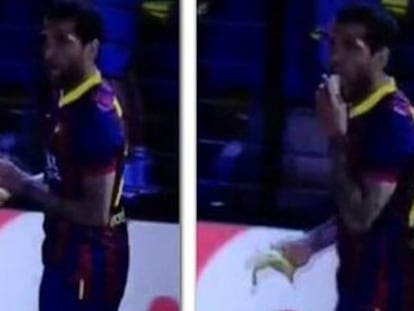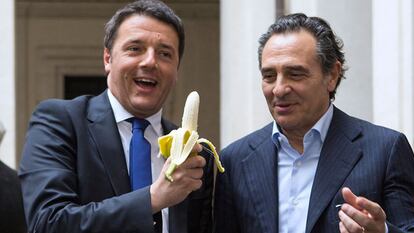Just another “isolated” racist incident?
The throwing of a banana at Barça’s Alves highlights the reluctance to tackle racial abuse in sport
Perhaps, the problem of racism in sport can be explained by sport itself, and that the explanation is really the problem: frustration, exclusion, the herd mentality, overexcitement, the subconscious… Somewhere in there lie the reasons for the racist behavior of some fans, more visible in the most popular sports but far from absent in others. And once this is established, the people who run sport relax, and measures to combat racism slide, because, as we all know, soccer is hugely popular and we all know how people can get carried away in the heat of the moment.
The initial response of the authorities to the banana that was thrown at Barcelona’s Dani Alves during an away match at Villarreal on April 27 was that it was an isolated incident. The problem is that the history of sport, in Spain and around the world, is full of isolated incidents. And after a while, they all add up.
Which is not to say that in some countries action isn’t finally being taken against racism in sport. Donald Sterling, the owner of the Los Angeles Clippers basketball franchise, was recently banned for life from the game, and will likely be forced to sell up after he was recorded telling his girlfriend in no uncertain terms that he didn’t want her bringing black people to games.
“The attitude of the State Commission Against Violence and Racism is lazy and laissez-faire,” says Esteban Ibarra, a member of the two anti-racist organizations in Spain. “All that happens here is that we cover up racism and violence.” It is an attitude that many sports fans will recognize from the way the Spanish authorities have failed to deal with doping.
Degrees of tolerance
When Donald Sterling, the owner of the Los Angeles Clippers basketball team, told his girlfriend to stop bringing black friends to games, he knew what he was saying; he just never imagined that his words were being recorded, and that they would end up being heard by President Obama, along with the rest of the planet. When a Villarreal fan threw a banana at Barcelona’s Dani Alves during last week’s game, he too knew what he was doing, but never imagined that the player would pick the banana up, take a mouthful, and in so doing send a message out around the world. They are two examples of racism in sport that happened more or less at the same time. But there the comparisons end.
Sterling has been sanctioned by the NBA, while his players threatened to go on strike. The response to the event at Villarreal has not been quite as vigorous, although the man responsible for throwing the banana has been banned for life from the club. Intolerance toward racism seems to be progressing more across the Atlantic than in Europe. Black players were never officially segregated in European team sports, as they were in the United States until the mid1950s, but they did not become a significant presence in European soccer until the 1980s. The NBA has come a long way since the days when black players had to eat and sleep on the tour bus because they were not allowed into the same hotels as their white teammates: by 2011, they dominated basketball, with 338 black players in the NBA compared to 54 white Americans and 52 white overseas players. At the same time nine of the league’s 30 coaches were black. The Harlem Globetrotters of the 1970s paved the way for later generations of black basketball stars.
The people who run European soccer may not have segregated black players, but they have done little to combat racism in the stands, where each week at hundreds of games in dozens of countries, particularly in Eastern Europe, fans hide behind neo-Nazi symbols, shouting racist abuse at black players who have been signed by their own teams. But until the authorities in countries such as Spain take serious action to combat the racism, both latent and active, that runs throughout society, then players like Alves will continue to suffer abuse. The first meaningful sanction has yet to be handed down against a club or individual.
Fifa, world soccer’s governing body, gives the impression that it doesn’t take racism seriously. When Milan player Kévin Constant, a French player originally from Guinea, walked off the pitch after tiring of racist chanting from the terraces in a non-competitive game last summer, Fifa reprimanded him, saying in an official statement: “This is not a long-term solution.”
Adriano Galliani, Milan’s CEO, agreed. “This is all very sad, but you can’t just walk off the pitch,” he said.
In 2006, Samuel Eto’o, then playing for Barcelona, came close to abandoning a game at Zaragoza when fans taunted him by making monkey noises. Ronaldinho was set to join him, but the pair were finally persuaded by coach Frank Rijkaard to finish the game. No action was taken against the racists in the terraces.
Spain’s grandly titled Anti-Racism Commission rarely takes action beyond announcing that this or that soccer match is “high risk”. What happens inside or outside the stadium depends on the referee, security staff, or the police. In 2005 and 2006, Getafe and Racing Santander were both fined €6,000 for failing to prevent racist chanting in the terraces.
Stadiums offer hardcore fans a hiding place where they can act out their fantasies, a place where they know they are safe, and where the authorities’ response to outrages will be laughable. The soccer pitch is a place of symbolic conflict, where the opposite side is the enemy, and where violence can be ritually acted out against supporters of the other team. These kinds of soccer fans are locked in a world of racism, homophobia and violence. Justin Fashanu, the first black footballer in England’s top division to command a £1-million transfer fee, was also the first player to come out as homosexual. After retiring from the game he went to live in the United States, where, in 1998, he was accused of sexual assault by a 17-year-old. He fled the country, and committed suicide a few months later.
Anti-racism legislation is tough: the problem is that it is rarely applied, and when large groups of fans are involved, the only action is against the club. Villarreal soccer club has banned a 26-year-old fan for life over the Dani Alves incident. But many Spanish clubs have not only tolerated racism and violence by ultras, or hardcore fans, but actually protected them, playing the “isolated incident” card again and again.
Such is the extent of racist language in Spanish soccer, that there was surprise and shock in 2004 after the British media protested that Spanish national coach Luis Aragonés had called Thierry Henry a “black shit” during a training session. Aragonés refused to apologize, saying the comment was made in private. Uefa later fined the Spanish Football Association.
Racism, or seemingly racist attitudes, are not isolated to soccer in Spain. In 2008, the national basketball side posed for photographs making “slant-eyed” gestures during the Beijing Olympics, causing international uproar. Team members José Calderón and Jorge Garbajosa were puzzled by the hostile reaction, the latter commenting: “We don’t feel we did something bad. It’s wrong to interpret it as racist.”

The issue came up again in 2008 during Madrid’s bid to host the 2012 Olympics, when the organizing committee issued a statement following yet another incident where Eto’o had been the victim of racist chanting, this time at Málaga.
In another incident earlier that year, Getafe’s Ecuadorian forward Joffre Guerrón was racially abused during a match at Sporting Gijon.
Earlier in 2008, hate messages were posted on a Spanish website targeting British Formula 1 world champion Lewis Hamilton. Hamilton, the sport's first black driver, was also subjected to racial abuse from spectators during testing in Barcelona in February that year, after which Formula 1's governing body launched an anti-racism campaign.
Since then, Uefa and Fifa have launched their own campaigns aimed at ridding soccer of racism. Dilma Rousseff, the president of Brazil, which is hosting the World Cup this year, says Pope Francis will be sending a message to be read out before the opening game of the tournament by a member of the Brazilian squad. “From now on, we are all monkeys,” said Rousseff, joining in the campaign started by Alves’ teammate Neymar.
Following the incident on April 27, the Barcelona striker posted an image of himself on the social networks with his infant son eating a banana. Under the picture was the hashtag #weareallmonkeys, in English, as well as in Portuguese, Spanish and Catalan.
Neymar’s move has garnered global support: he has over 10 million followers on Twitter and 4.6 million on Instagram. Inspired by Neymar, more than 100,000 people have used the hashtags to strike humorous poses with banana in hand.
Tu suscripción se está usando en otro dispositivo
¿Quieres añadir otro usuario a tu suscripción?
Si continúas leyendo en este dispositivo, no se podrá leer en el otro.
FlechaTu suscripción se está usando en otro dispositivo y solo puedes acceder a EL PAÍS desde un dispositivo a la vez.
Si quieres compartir tu cuenta, cambia tu suscripción a la modalidad Premium, así podrás añadir otro usuario. Cada uno accederá con su propia cuenta de email, lo que os permitirá personalizar vuestra experiencia en EL PAÍS.
¿Tienes una suscripción de empresa? Accede aquí para contratar más cuentas.
En el caso de no saber quién está usando tu cuenta, te recomendamos cambiar tu contraseña aquí.
Si decides continuar compartiendo tu cuenta, este mensaje se mostrará en tu dispositivo y en el de la otra persona que está usando tu cuenta de forma indefinida, afectando a tu experiencia de lectura. Puedes consultar aquí los términos y condiciones de la suscripción digital.
More information

“We are all monkeys”
Últimas noticias
The complicated life of Francesca Albanese: A rising figure in Italy but barred from every bank by Trump’s sanctions
How Japan is trying to avert ‘digital defeat’
Half of Scotland is in the hands of 420 property owners
Reinhard Genzel, Nobel laureate in physics: ‘One-minute videos will never give you the truth’
Most viewed
- Pablo Escobar’s hippos: A serious environmental problem, 40 years on
- Why we lost the habit of sleeping in two segments and how that changed our sense of time
- Charles Dubouloz, mountaineering star, retires at 36 with a farewell tour inspired by Walter Bonatti
- Reinhard Genzel, Nobel laureate in physics: ‘One-minute videos will never give you the truth’
- The Florida Keys tourist paradise is besieged by immigration agents: ‘We’ve never seen anything like this’









































